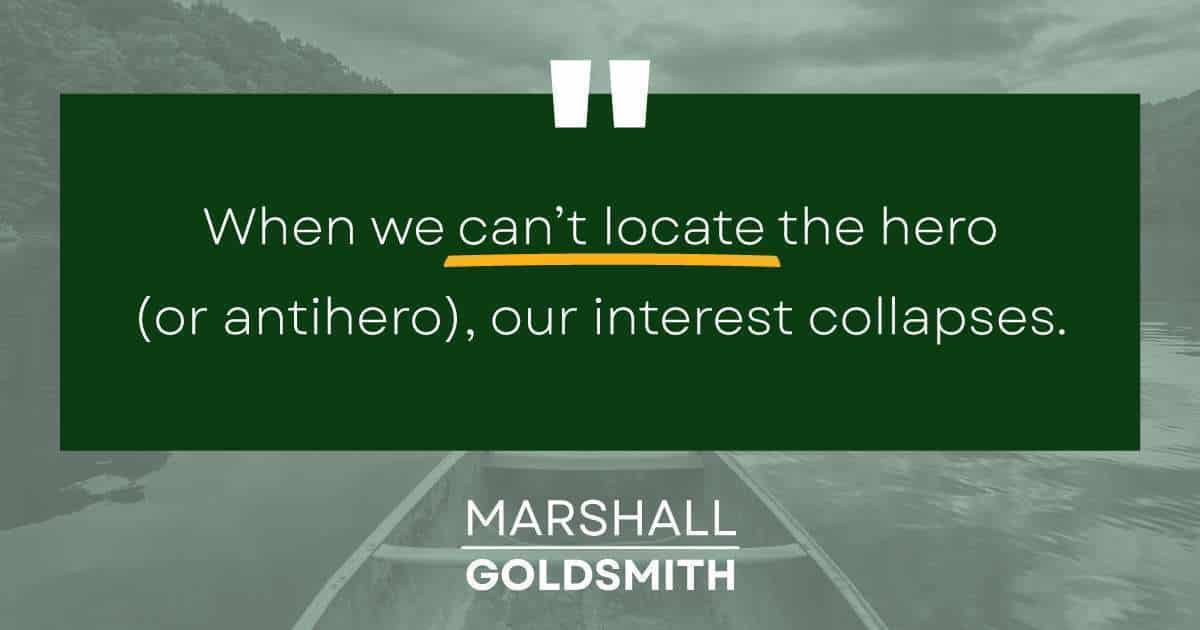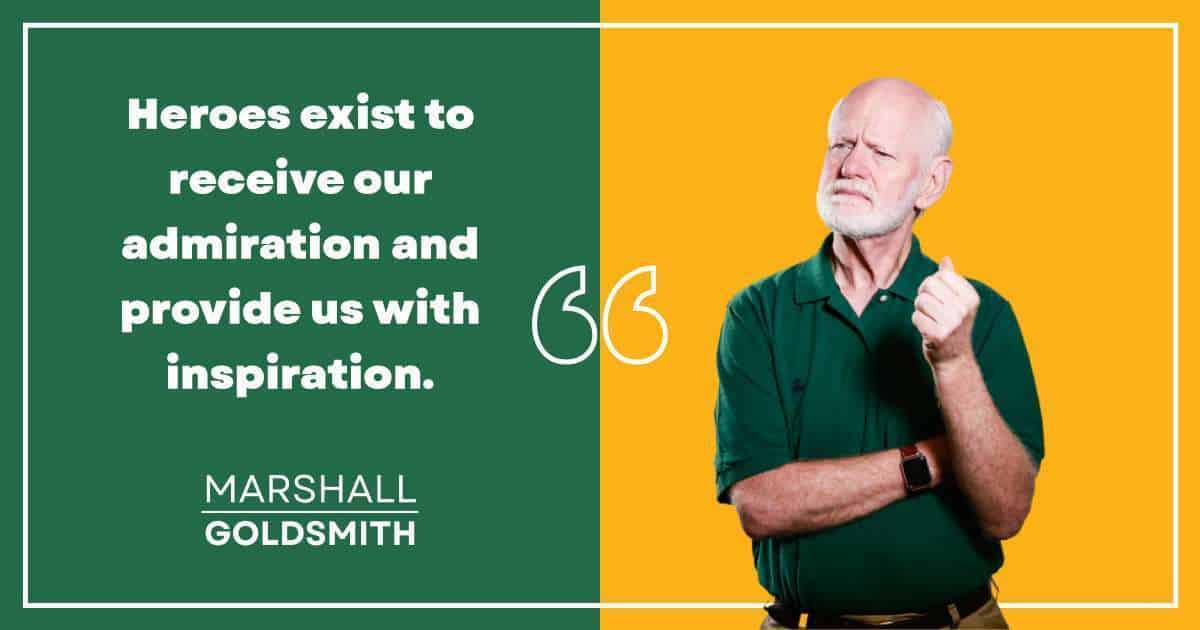Playing Favorites By Marshall Goldsmith There’s a reason I devote...
We all need heroes. It is a need so strong that every narrative we encounter—whether it’s a short story or a film or a joke—must contain a clear hero figure in order to hold our attention.
When we can’t locate the hero (or antihero), our interest collapses. Heroes exist to receive our admiration and provide us with inspiration. This is not a controversial notion. But I needed the help of my friend, Ayse Birsel, a Turkish-born industrial designer, to help me take a fascination with the heroic into an Aspiration for becoming one.
It began with a simple question after I had spent hours prodding participants in one of Ayse’s “Design the Life You Love” seminars to be bolder in deciding what they wanted to do next. At one point, one of the participants turned the tables on me:
“If you think it’s so easy, what’s next for you?” one of them asked me.
I went blank. Ayse, a master problem solver, tried to help. “Let’s start with a simple question,” she said. “Who are your heroes?”
That was easy. I said, “Alan Mulally, Frances Hesselbein, Jim Kim, Paul Hersey, Peter Drucker. And, of course, Buddha.” I said.
“Why?” she asked.
“Well, I’m a Buddhist. And Drucker, who became a mentor late in his life, was the greatest management thinker of the twentieth century.”
“Okay, but what’s ‘heroic’ about them other than you like their ideas?”
“They gave away everything they knew to as many people as they could, so others could pay it forward. Even though Buddha’s been dead twenty-six hundred years, and Peter Drucker died at age ninety-five in 2005, their ideas survive,” I said.
“Why not be more like your heroes?” she said.
That was the moment I realized I could do more than admire my hero-teachers.
I could adopt their ideas.
I could Aspire, however modestly, to become what most impressed me about them. In this way, my ongoing Aspiration began to share what I know. How to go about it didn’t gel with me right away, but Ayse had planted the seed. And it grew, which is how I “accidentally” formed my small community of like-minded people known as 100 Coaches. If I can do it, you can too.
DO THIS:
We place our heroes on pedestals too high to reach, rarely considering them as role models to copy. The four steps in this exercise correct that error:
Write down the names of your heroes.
Write down one-word descriptors of the values and virtues that endear them to you.
Cross out their names.
Write your name in their place.
Then wait for your next big Aspiration to appear.

EXERCISE
Resolve Your Dichotomies
This exercise is also inspired by Ayse Birsel. And it, too, involves crossing out words, so keep your pencil handy.
In 2015, when she was launching her “Design the Life You Love” seminars, Ayse asked me to bring a few friends to one of her first outings in New York—to fill up seats, since only six people had signed up. I brought seventy. If Ayse was nervous or intimidated by the big crowd, I couldn’t detect it. But I also knew that talking for an hour or more to an audience of several dozen strangers requires a little more projection of personality than talking to six people. Six people make a dinner party, six dozen make an audience. So I decided to help raise her energy level.
Ayse had once told me, “If I were stranded on an island and could have only one creative tool, it would be dichotomy resolution.”
Her favorite part of product design was resolving “either/or” decisions that the client left to her discretion, such as whether the design should be classic or modern, small or functional, stand-alone or expandable into a product line, and other choices. Ideally, in design it’s a mash-up of both — a classic design but updated with modern materials, such as the Ford F-150 pickup with an aluminum body instead of traditional steel. But the dichotomies in our everyday behavior seem to demand resolution rather than forced integration. Optimist or pessimist? Joiner or loner? Active or passive? Pick one or the other — you can’t be both.
Remembering her affinity for dichotomies, I took Ayse aside moments before the seminar began.
“I don’t know if you’ve ever resolved the extrovert versus introvert dichotomy in your life,” I said, “but today’s not the day to choose introvert. Let’s sing.”
I started singing “There’s No Business Like Show Business.” Amazingly, she knew the words and joined me. Afterward, when she finished laughing, I told her, “Remember this feeling. The audience isn’t here for another business meeting. This is showtime!”
Half of us see the world in black and white — the other half see shades of gray.
Like Ayse, I’m in the first group (the previous sentence is proof). If you’re like me, you know that seeing the world as an endless string of dichotomies won’t automatically simplify your decision making. You’ve merely reduced your many options to two. You still have to choose one. This is especially critical at the start of the aspiration process. Unless you’re hoping to flip your personality completely, your aspirations should not conflict with your core preferences, virtues, and quirks.
You need to identify the dichotomies that regularly reappear in your life, especially when they’re a recurring source of problems or failure (for example, procrastination as opposed to timeliness). Then you have to resolve them, deciding which half you want to own.
DO THIS: List all the dichotomies that come to mind.
You have three rounds of decision making:
First, make a list of as many interesting dichotomies as you can think of.
Second, use a Sharpie to completely redact each unchecked dichotomy that doesn’t really apply to you.
Finally, study the remaining dichotomies and decide to determine which half of each pairing reflects you.
Are you a leader or follower? Life of the party or wallflower? Present or distracted? Ask partners or friends for their opinion, if it helps. Now, cross out the half of the pairing that doesn’t apply. You should end up with a sheet of blacked-out words that looks like a government redaction of a CIA agent’s memoir. The remaining unobscured words reveal your defining qualities.
You can’t argue with the picture they paint. You painted it. These qualities not only influence what you aspire to, but whether or not you will earn it.
Bonus round:
Share (if you dare) your finished sheet with the people who know you best, for valuable feedback.

Adding Too Much Value Won’t Get You There By Marshall...
C-Suite Master Class: No, But, However By Marshall Goldsmith Continuing...
The Doerr Institute: Expanding the Market for Coaches By Marshall...
Making Leadership Development Part of the College Degree at Rice...
Sanyin Siang – Winner of the Thinkers50 Marshall Goldsmith Coaching...
Thinkers50 Marshall Goldsmith Distinguished Achievement Award in Coaching – Nominees...
Leading with Influence: What Is Influence360°? By Marshall Goldsmith Founder...
Are You a Dominator, Manipulator, Persuader or Influencer? By Marshall...
Leading with Influence: Redefining Modern Influence Part 2 By Marshall...
My mission is simple. I want to help successful people achieve positive, lasting change and behavior; for themselves, their people, and their teams. I want to help you make your life a little better. With four decades of experience helping top CEOs and executives overcome limiting beliefs and behaviors to achieve greater success, I don’t do this for fame and accolades. I do this because I love helping people!
As an executive educator and coach, I help people understand how our beliefs and the environments we operate in can trigger negative behaviors. Through simple and practical advice, I help people achieve and sustain positive behavioral change.